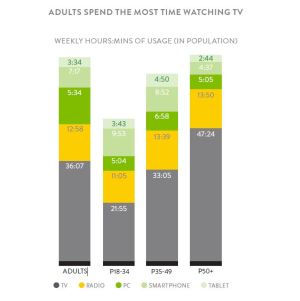Over the past few days, I have seen a post on TV measurement from The Wall Street Journal make the rounds on numerous media blogs and groups on LinkedIn and thought it would be worth highlighting here.
 The basic story is that Nielsen has attempted to measure across different platforms – as Nielsen uniquely can – to see where people really spend their time between various devices – namely Television, Radio, PC’s, and Smartphones. Low and behold, when one makes a genuine effort to paint an entire picture, not a partial one, then it becomes clear that the TV landscape is not ready to die just yet. The same narrative could also be made about FM/AM radio when making comparisons to the many streaming competitors – even in the US market where radio usage has been in long-term decline since before the arrival of iPods, iPhones, and numerous new audio services.
The basic story is that Nielsen has attempted to measure across different platforms – as Nielsen uniquely can – to see where people really spend their time between various devices – namely Television, Radio, PC’s, and Smartphones. Low and behold, when one makes a genuine effort to paint an entire picture, not a partial one, then it becomes clear that the TV landscape is not ready to die just yet. The same narrative could also be made about FM/AM radio when making comparisons to the many streaming competitors – even in the US market where radio usage has been in long-term decline since before the arrival of iPods, iPhones, and numerous new audio services.
Nielsen’s newly released Quarter 1 Total Audience Report is well worth the read. It’s another example of how Nielsen has to persist by being as objective as it can to all of the different platforms it can measure – as well as be one of the few trying to paint that entire picture, with or without comparable metrics and a full dataset.
It has to be nice to everyone to ensure that both broadcasters and digital players stay with Nielsen and don’t go off and seek another measurement company or another metric that likes them better.
It’s also telling that cross-media measurement still has a long, long way to go to best understand the value of how different media can be measured equitably. Note that the WSJ article gets a little sidetracked with comparing seconds of video and minutes of TV – a notable point, but the report has so much more to say.
At some point – the optimist in me says 3 years, but it could be as many as 5-10 – this understanding of old and new media will be a thing of the past and reports like this will update the trends on what is up and what is down. In the meantime, we’re still stuck in this offline, online world.


